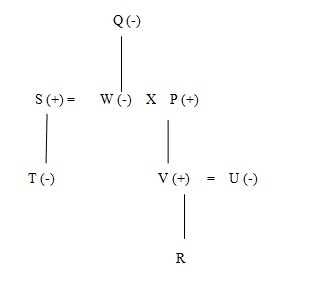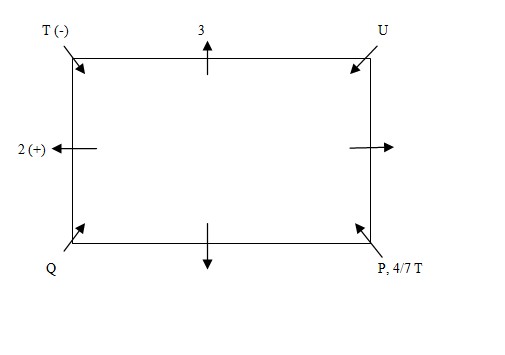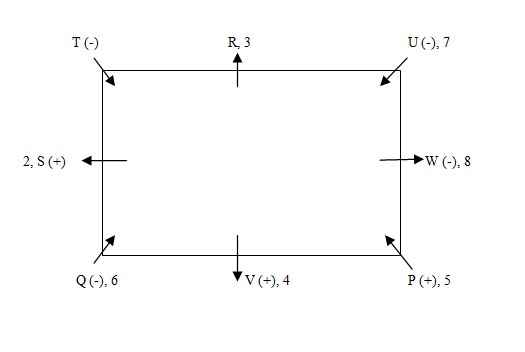Question
How many coins does W have?
Read the following information carefully and answer the questions given below it: P, Q, R, S, T, U, V and W are sitting around a square table in such a way that four of them who sits at the corner are facing towards the centre and other four who sits in the middle of the table are facing outside the centre. Each person has different number of coins viz. 1, 2, 3, 4, 5, 6, 7 and 8, but not necessarily in the same order. Only one person sits between W and V. V sits second to the right of the person who has 8 coins. W’s brother S, sits on the immediate left of his mother who has 6 coin. P is the father of V and only one person sits between W’s mother and T. S’s daughter sits second to the right of U and on the immediate left of that person who has 3 coins. Q sits second to the left of W’s husband who has neither 4 nor 7 coins. U, who is sister of V, has 7 coins and is not an immediate neighbour of W’s husband. T sits on the immediate right of the person who has 2 coins. S’s daughter has 1 coin. Only one person is sitting between P and U. No female is an immediate neighbour of Q, who sits at the corner of the table. V is father of R and is not an immediate neighbour of T. P is married to W.Solution
W’s brother S, sits on the immediate left of his mother who has 6 coins. P is the father of V and only one person sits between W’s mother and T. U, who is sister of V, has 7 coins and is not an immediate neighbour of W’s husband. V is father of R and is not an immediate neighbour of T. P is married to W. By the statement ‘only one person sits between W’s mother and T’, we find that Q is W’s mother and T is S’ daughter.  No female is an immediate neighbour of Q, who sits at the corner of the table. Q sits second to the left of W’s husband who has neither 4 nor 7 coins. Only one person is sitting between P and U. S’s daughter sits second to the right of U and on the immediate left of that person who has 3 coins. T sits on the immediate right of the person who has 2 coins.
No female is an immediate neighbour of Q, who sits at the corner of the table. Q sits second to the left of W’s husband who has neither 4 nor 7 coins. Only one person is sitting between P and U. S’s daughter sits second to the right of U and on the immediate left of that person who has 3 coins. T sits on the immediate right of the person who has 2 coins.  S, sits on the immediate left of his mother who has 6 coins. V is not an immediate neighbour of T. So, V can sit at immediate right or immediate left to P. If V sits immediate right to P, and as we know that W is female so she sit at immediate left to T. We know that V sits second to the right of the person who has 8 coins. By this statement this condition is not possible. If V sits immediate left to P, so W will sit at immediate right to P. Then R will sit at immediate left to T. Further V sits second to the right of the person who has 8 coins. It is given that T has 1 coin and that of U is 7. So V will have 4 and P will have 5 coins
S, sits on the immediate left of his mother who has 6 coins. V is not an immediate neighbour of T. So, V can sit at immediate right or immediate left to P. If V sits immediate right to P, and as we know that W is female so she sit at immediate left to T. We know that V sits second to the right of the person who has 8 coins. By this statement this condition is not possible. If V sits immediate left to P, so W will sit at immediate right to P. Then R will sit at immediate left to T. Further V sits second to the right of the person who has 8 coins. It is given that T has 1 coin and that of U is 7. So V will have 4 and P will have 5 coins 
Recently an Online platform ‘Trade nxt ’ which enables corporate, and MSMEs to transact all cross-border export-import transactions, has bee...
How much is requirement of initial paid up capital to open Small Finance Bank ?
The extension of the Armed Forces (Special Powers) Act (AFSPA) in parts of Nagaland and Arunachal Pradesh reflects ongoing concerns regarding:
Recently Nepal and which among the following has signed an agreement of USD 659 million for Nepal’s development assistance?
What is the name of the project under which India has developed the world's first portable disaster hospital, known as the Aarogya Maitri Cube?
What is the primary purpose of the "Skills on Wheels" program launched by Lend A Hand India?
What growth rate did India's defence production achieve in FY24?
Who were the two Indian players who represented India in the winning team at the 2025 Asian Snooker Championship?
Which country will host the 2026 G20 Summit, reaffirming its commitment to the G20 initiatives for a global geopolitical and economic order based on equ...
Which bank will sign a 200 million euro (about Rs 1,800 crore) Line of Credit (LoC) with the European Investment Bank (EIB) for supporting climate act...



